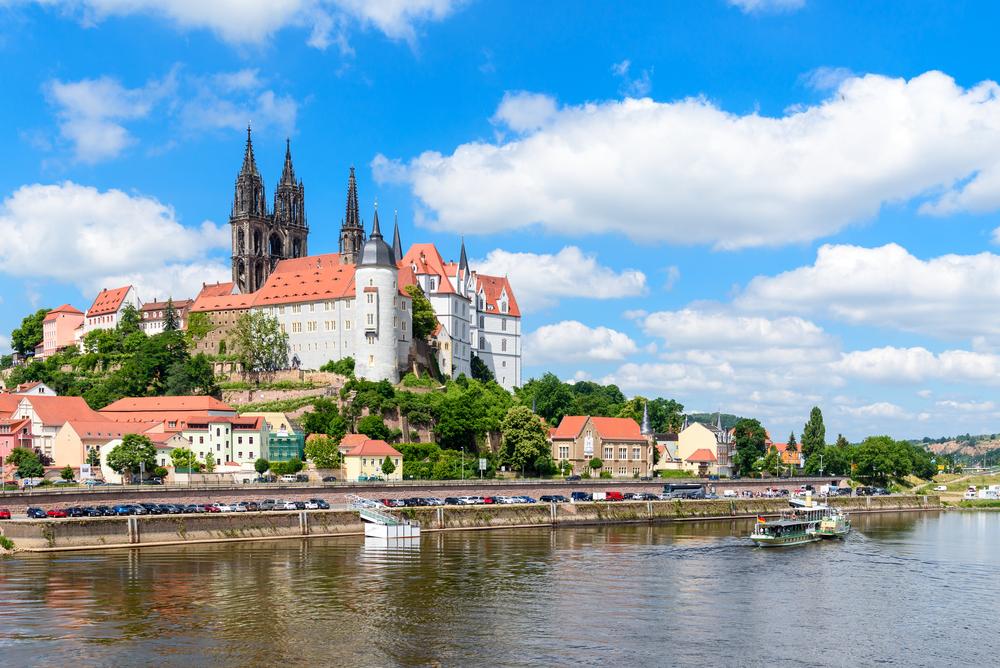European river cruising seems to increase in popularity every year, and trips along the Danube, Rhine, and Seine are apparently the most popular; however, I’ve just discovered a fantastic cruise, run by Viking, between Prague and Berlin, along the Elbe River. And it’s definitely worthwhile.
A Unique River Cruise
What makes this particular river cruise especially unique is that it’s more tranquil, as there aren’t nearly as many other cruise ships sharing space on the Elbe River.
Meissen, Germany, home to Albrechtsburg Castle. Shutterstock
This made the cruise more peaceful than navigating on the busier rivers. The Elbe can be rather narrow, making it feel more intimate at times.
We passed sheep and cattle along the riverbanks, which added to the natural setting and solitude. There were, of course, lots of shorebirds such as herons, kites, storks, and cranes, too; and we passed lush forested areas, rolling hills blanketed with vineyards, stunning limestone cliffs, and several great castles.
This particular river can be rather fickle because the water level can change quickly. Last summer, for example, the water level decreased so much that the cruise could no longer go the entire route, so buses and hotels had to be used for a portion of the trip. However, when my wife and I took the trip in late spring this year, it was smooth sailing under perfect conditions.
The Beginning and the End
The cruise is sandwiched between visits to two magnificent European cities: Prague and Berlin.We stayed at the Prague Marriott Hotel and the Hilton Berlin Hotel for two nights each, giving us time to explore these beautiful destinations. While in Prague, the city of spires, I visited its massive Prague Castle with its Gothic St. Vitus Cathedral, where St. Wenceslas is entombed, as well the historic Charles Bridge, which is always crowded with pedestrians. In the old town, the 15th-century astronomical clock comes alive with its Walk of the Apostles on the hour.
While in Berlin, I checked out Checkpoint Charlie, once the only crossing point between East and West Germany; the Holocaust Memorial, designed by American architect Peter Eisenman; and Brandenburg Gate, which has become a symbol of the reunification of Germany.
Cruising on the Elbe River
The Elbe River is one of the major waterways of central Europe, and it runs from the Czech Republic through Germany to the North Sea. Our cruise began at Decin in the Czech Republic and ended in Germany’s Wittenberg.In Wittenberg, we walked in Martin Luther’s footsteps to the Castle Church where Luther triggered the Protestant Reformation in 1517 by posting his “95 Theses” on the church door. As we cruised on the Viking Astrild between Decin and Wittenberg, we encountered several other highlights, too. One of these memorable moments was a visit to the city of Dresden, nicknamed the “Florence of the Elbe.” It was badly damaged by bombs in World War II, but has risen like a phoenix from the ashes of the war. We were able to visit such architectural wonders as the Zwinger Palace, now used as a museum complex; Dresden Castle, home of the Green Vault, with its many priceless jewels and emeralds; and the Semper Opera House.

We docked across from the Parliament Building in Dresden. John M. Smith
Another highlight was a visit to Meissen, where fine porcelain pieces are still made by hand at the Meissen porcelain factory. It was very interesting to be able to view the actual process and then to see the exquisite finished products on display.

A hand-painting demonstration at the Meissen Porcelain Manufactory. John M. Smith
While in Meissen, we took a walking tour to the 15th-century Meissen Castle and then descended into the market square. It was here that our tour guide introduced us to fummel, a special traditional pastry. The dough is rolled wafer-thin, so it inflates like a balloon when baked but is actually hollow inside. I was asked to demonstrate this for our group, so I poked the thin outer layer and discovered that the pastry was empty inside!
Indeed, all these recollections were memorable moments, but my favorite was a visit to the spectacular rock formations in Germany’s Saxon Switzerland National Park. My hike through these sandstone monoliths and across the Bastei Bridge, a 200-year-old stone footbridge that spans a very deep ravine, was, indeed, awe-inspiring. I perched high above the Elbe River, peering down. What a place for photos! Later, I would see this same area again, but from a different perspective, as we cruised on the Elbe River, past these exquisite rock formations. I even saw some thrill-seeking rock climbers ascending.
Aboard the Viking Astrild

The Viking Astrild is docked along the Elbe River. John M. Smith
There were 92 guests and a staff of 32 on the Viking Astrild. I was especially impressed by the teamwork shown by this staff. This was particularly demonstrated during a special luncheon barbecue, where all the staff pitched in to make it work flawlessly.
Although we had several informative land excursions, we also had time to simply relax on board and enjoy such evening entertainment as the classical Allegria Ensemble and the Renaissance Times, which combined Renaissance music, anecdotes, and fashion. All in all, it was a wonderful cruise.
John M. Smith is a travel writer and photographer who resides in Canada, in Ontario’s Prince Edward County.
The author was a guest of Viking River Cruises.





